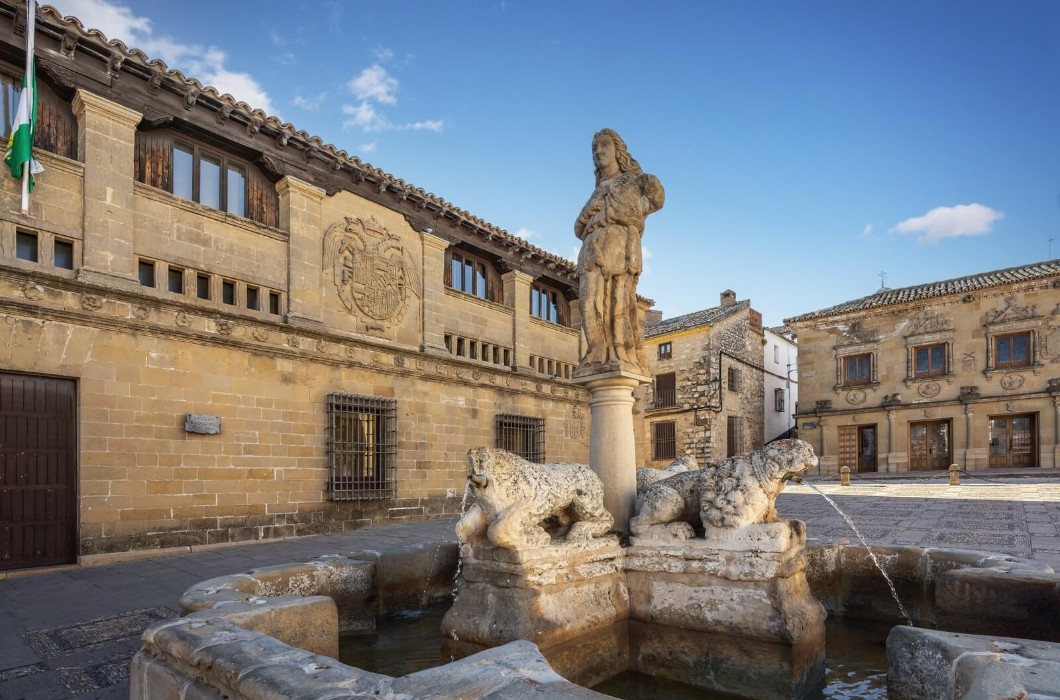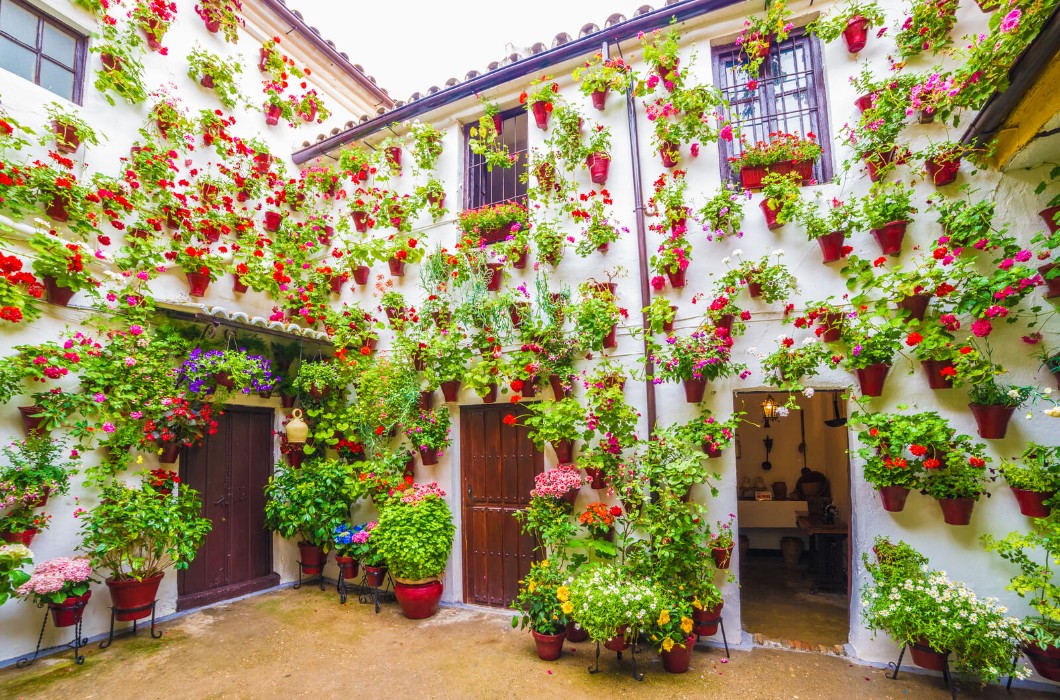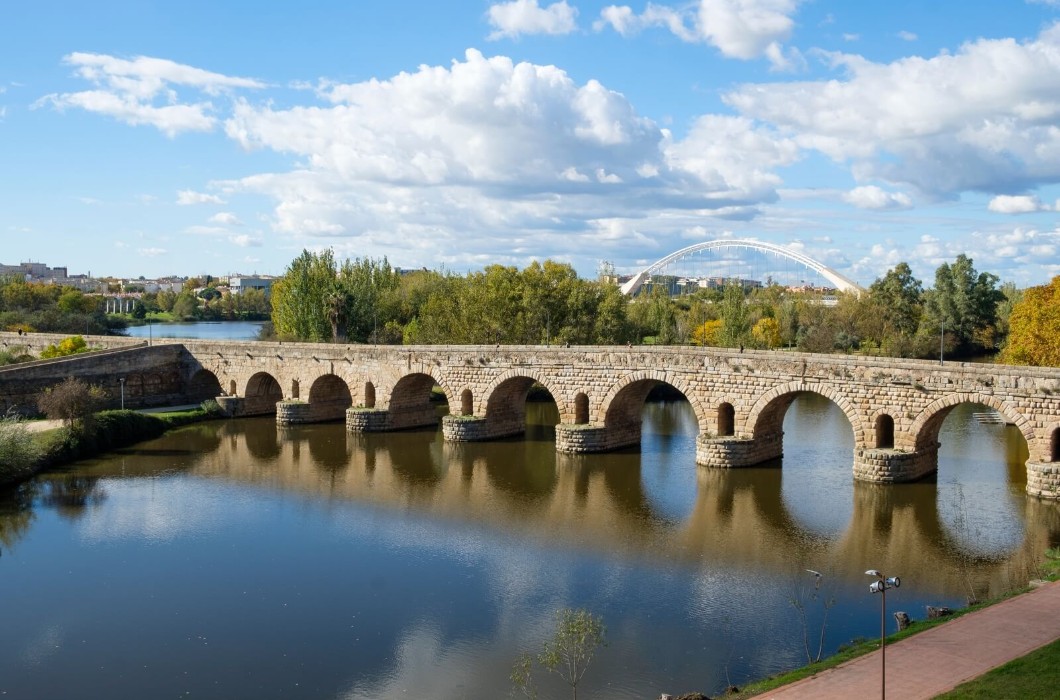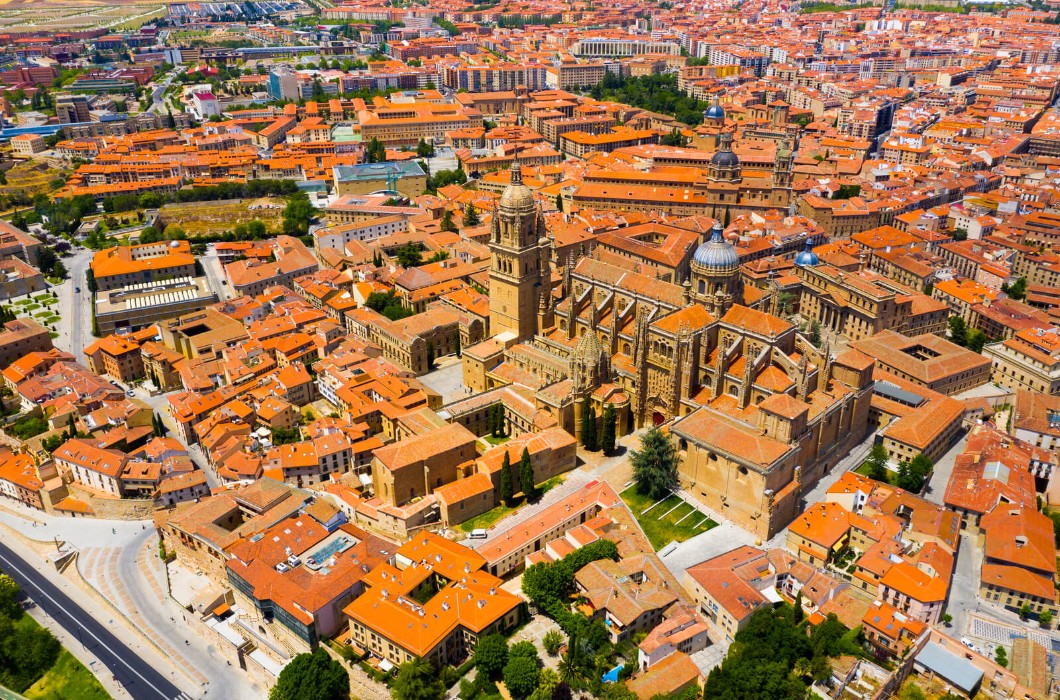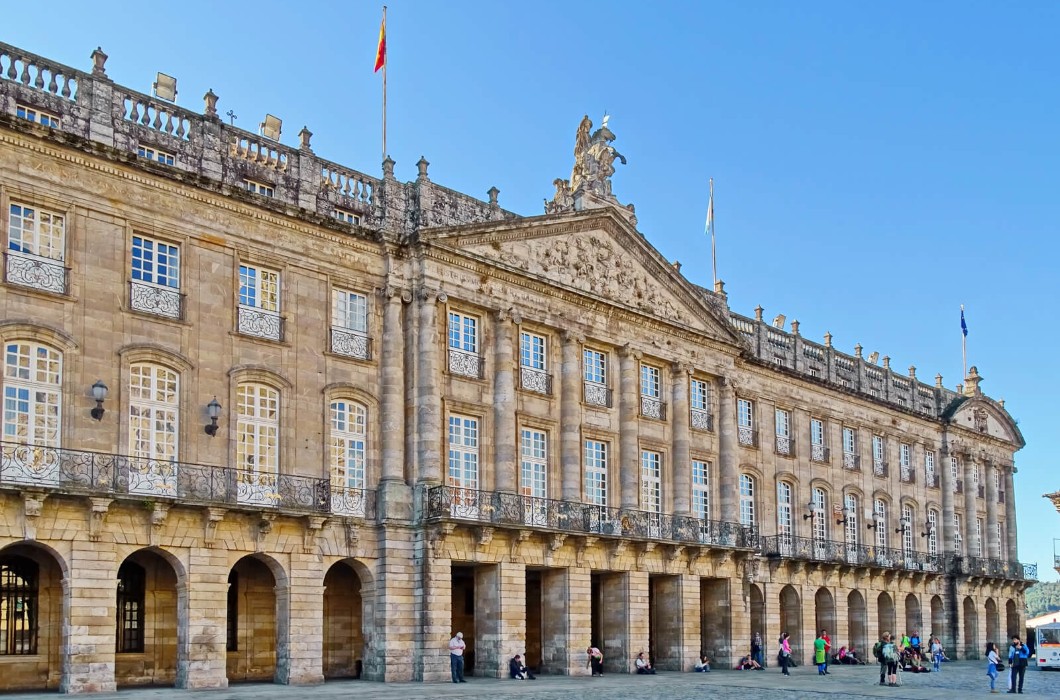Bienvenido a España! It is here you will find a land and people that has been shaped over a thousand years of competing influences. Through different empires and spiritual awakenings, the country’s history can be seen in every dish, every building and every song. No more can this distinct character be experienced than in its 15 World Heritage cities that showcase an identity and tradition that captivate locals and visitors alike. It’s time to discover the soul of Spain.
1. ALCALÁ DE HENARES
For those looking to escape the thronging streets of Madrid, head north along winding roads that wrap around verdant countryside to the pleasant city of Alcalá de Henares. The mornings are sleepy here, with the clacking of giant storks announcing that it’s time to begin your day. Take a wander down Calle Mayor, Spain’s longest porticoed street, which comes alive at midday as shops raise their shutters and hungry diners take up residence at the tables and chairs that line the pedestrianised thoroughfare. Here, you will find the perfectly preserved abode of Miguel de Cervantes, author of the legendary Don Quioxte. The town is also where Universidad de Alcalá is found, Spain’s first university and campus. Students matriculated here for 20 years before undergoing an all-day examination in front of their peers and teachers at the Paraninfo—the great hall—and for those who failed, they were branded with a pair of donkey ears. Today, the venue is the setting where the King and Queen of Spain present the Cervantes Prize for Literature on April 23.
2. ÁVILA
Imposing medieval city walls give way to stretches of cobbled streets, gorgeous churches and a wonderful tranquil atmosphere that seeps through every pore of this pretty city. If you can handle the rarefied air—Ávila is found at 1,122 metres above sea level, making it Spain’s highest provincial capital—then you will be rewarded with a place that oozes spectacular architecture, history and religion. Enjoy a stroll along a 1,700 metre walkway atop the city walls, boasting epic views of the surrounding lush countryside as well as a different perspective of Fruchel’s Cathedral, believed to be the country’s first Gothic cathedral. When stomachs rumble, treat yourself to a succulent T-bone steak or beans from El Barco de Ávila before finishing off with the sweet yemas de Santa Teresa, named after the famous Saint Teresa de Jesús, whose presence can be found all over the city. When night falls, escape the city walls to Cuatro Postes viewing point, which offers a prime position to see the wall’s true grandeur under spotlights.
3. BAEZA
A city that stands as an island in an ocean of olive groves, Baeza is a dream destination for gourmands and those who worship the poetic word. Located in the province of Jaén, the city is where the two legendary poets of Spanish literature, Antonio Machado and Federico García Lorca first came into contact. Pull up a chair at one of the city’s enticing restaurants and delve into dishes where extra virgin olive oil is the star ingredient. There’s bacalao a baezana (cod) and soups like potaje (vegan stew) and andrajos (rabbit stew) as well as ochío, a bread made with olive oil. You can even savour some olive oil ice cream before educating yourself on the small fruit at the Olive Culture Museum. After your appetite has been sated, wander the maze of streets that reveal gorgeous buildings and pretty whitewashed houses. Make sure to include the three squares—Plaza de Santa María, Plaza de Santa Cruz and Plaza del Pópulo—in your walking tour to catch a glimpse of Jabalquinto Palace and the Fountain of the Lions.
4. CÁCERES
Start your journey in the heart of Cáceres at Plaza Mayor. A bustling square full of bars and cafes, in past centuries it was the scene of bullfighting and jousting. The violent pursuits may be long gone, but it is still recommended to grab a chair and a drink and engage in a spot of people-watching as the locals go about their daily business. Aesthetes can indulge themselves at Fundación Helga de Alvear and the Museum of Cacéres, which sports works by Picasso and Miró and the world’s largest cistern. For lunch or dinner, tuck into local dishes of migas (fried breadcrumbs with chorizo and bacon), torta del Casar, an incredible cheese or morcilla patatera (potato sausage) and wash it down with a glass of Ribera del Guadiana Designation of Origin. For something more sophisticated, make an appointment at the three Michelin-starred Atrio. End your day in Cáceres with a dramatised tour with a troubadour retelling of legends by moonlight.
5. CÓRDOBA
The Great Mosque-Cathedral dominates most itineraries of visitors plotting a course for Córdorba and it is easy to see why. Plumped pretty in the heart of the city, the mosque is one of most beautiful examples of Islamic art in Spain. First built by the Muslim Emir Abdurrahman I, the Christian Conquest of 1523 saw a cathedral constructed inside featuring a Baroque altarpiece and mahogany choir stalls. The Alcázar de los Reyes Cristianos, the Synagogue and the Roman bridge are prime examples of how the city’s Christian, Islamic and Jewish influences have intertwined over the centuries. Away from the major monuments, lose yourself to a plethora of winding streets and alleys that reveal pretty squares, fountains and courtyards decorated with flowers. Time your visit to coincide with The Courtyard Festival, a World Heritage event, as well as the May Crosses and the Battle of Flowers as the city bursts into colour and noise with flowers found everywhere and outdoor flamenco shows. Finally, rejuvenate with an indulgent hammam in the Jewish Quarter’s Arab baths.
6. CUENCA
The City of Hanging Houses knows how to make a first impression. Bestowed with buildings that seem to be teetering over the gorge of the river Huecar, it is certainly a spot that lends itself to a social media pic. You can visit three of the lofty abodes including Casa de la Sirena, which is home to a restaurant that serves up reinterpretations of classic local dishes. When the plates have been cleared, set your compass towards the Plaza Mayor to check out the arcaded Town Hall and the 12th-century Cuenca Cathedral before crossing the iron footbridge of Puente de San Pablo for that picture perfect shot of the Hanging Houses. The town city is also full of quirky spots, with the San Martín district’s skyscraper and the tunnel of Calle Alfonso VIII being notable landmarks. Make sure to set time aside for the plethora of museums that inhabit the city like the Museum of Spanish Abstract Art, Antonio Saura Foundation, Antonio Pérez Foundation and the Science Museums.
7. EIVISSA
Better known as Ibiza to non-locals, this island needs no introduction. A bastion of sun, sand and booming nightlife, Eivissa has established itself as one of Europe’s travel hotspots. However, the idyllic island is so much more than nights out on the tiles and sun worshipping. For history buffs, head for Castell d’ Eivissa (Ibiza Castle). Sitting on its dominant perch that overlooks the Dalt Vila (Upper Town), the citadel comprises a multitude of buildings that date back to as early as the eighth century when the city was a Muslim stronghold known as Yebisah. Leave the castle’s confines behind and take the short walk to Catedral de la Virgen de las Nieves (Ibiza Cathedral) which showcases a diversity of architectural styles thanks to 18th century modifications added to its 14th century original Gothic structure. A trip to the Puig des Molins Museum-Necropolis and the Museum of Contemporary Art of Ibiza is also highly recommended before you calm those stomach murmurings with a selection of Ibizan cuisine, which is a blend of ingredients and flavours from the Spanish mainland and Mediterranean with a sprinkling of Moorish influence.
8. MÉRIDA
Discover the glory of the Roman Empire with a visit to this charming city in the province of Badajoz. There’s the 2,000-year-old theatre that continues to entertain audiences especially on lazy summer evenings when the International Classical Theatre Festival rolls into town. In June, gladiators and Rome’s legionnaires don their armour, unsheath their swords and take to the streets for the Emerita Lvdica festival. If you want to cast your eyes on some Roman art, visit the National Museum of Roman Art which displays mosaics and sculptures from the era. And if your thirst for Roman culture remains unquenched, check out the Temple of Diana, the Arch of Trajan, the Roman bridge, the Roman circus and the Acueducto de los Milagros. Take a break from Roman Mérida and embrace the gentle call of nature with a walk along the banks of Guadiana River. End the day with a 30-kilometre drive to Alange, where you can enjoy a dip in the UNESCO World Heritage-designated Roman baths.
9. SALAMANCA
It is said ‘to talk of culture is to talk of Salamanca’. A walk through the streets of its historical centre is a walk through centuries of art, history and knowledge. Start your Salamanca tour at the Old and New Cathedrals, where the aim of the game is to locate the astronaut carved in stone. Hint: it’s on the Puerta de Ramos of the New Cathedral. Once you have located your spaceman, head towards the skies and climb one of the cathedral’s towers to enjoy epic city skyline views. Back on ground level, continue your hunt for hidden figures at The University of Salamanca—this time you are looking for the stone frog hiding in the façade that is said to bring good luck to students. For gastronomes, take advantage of the city’s thriving dining scene and tuck into a variety of plates including hornazo, a pastry filled with egg and meats, or join a tapas tour along Calle Van Dyck.
10. SAN CRISTÓBAL DE LA LAGUNA
Say goodbye to the Spanish mainland for the moment and catch a flight to the Canary Islands for your stop in San Cristóbal de La Laguna. A World Heritage Site since 1999, the destination is all about colour with historical mansions displaying a kaleidoscope of pastel colours. Retaining its 16th-century layout that has inspired the blueprints of several Latin American colonial cities, most notably La Havana and Lima, the city offers a glimpse into the past with its pulchritudinous architecture. The best way to uncover all of the city’s gems is by booking a guided tour that encompasses Calle de San Agustín, which is home to Casa Salazar, the old Convent and the Palacio de Lercaro. The Cathedral and the Church of La Concepción are must-visits, with the latter offering travellers the chance to enjoy unimpeded views of the surrounding skylines. Allow your senses to go into overdrive at the La Laguna Market, packed with produce and freshly picked flowers, before helping yourself to island specialties like waffle ice-cream, bienmesabe (a Spanish dessert) or puchero canario (Canary Island stew).
11. SANTIAGO DE COMPOSTELA
For centuries, the burial place of the relics of James the Apostle has inspired thousands of pilgrims to undertake the 500-mile trek known as the Camino de Santiago. Lasting between four to six weeks, the finish line is considered the capital of Galicia and its legendary Cathedral. But whether you are a pilgrim or not, there are countless experiences to enjoy. The Mercado de Abastos food market is a smorgasbord of tastes and smells. Here, you can sample and purchase seafood fresh from rías, cheeses and Padrón peppers. For tapas aficionados, make a beeline for Calle Franco and Calle Raiña in the centre of the old town, where local delicacies include octopus a feira, scallops, Santiago cake and wines like Albariño, considered to be one of the world’s highest rated white wines. Spend a night at the luxurious Hostal de los Reyes Católicos—believed to be the oldest hotel on the planet—which offers easy access to the Cathedral and Raxoi Palace. Art lovers should visit the Galician Centre of Contemporary Art and Cidade da Cultura for the work of Peter Eisenman and contemporary Galician architecture.
12. SEGOVIA
This fairy-tale Castilian city doesn’t wait around when it comes to impressing new visitors. Welcoming locals and travellers at its entrance is the magnificent 167-arch aqueduct that has been standing since the days of the Roman Empire. When you can drag yourself away from this incredible feat of engineering, Segovia rewards you with an array of towers, Romanesque churches, synagogues and a fortress. Two essential stops are the Cathedral, termed the ‘lady of the cathedral’ and the Alcázar, a castle filled with hidden passageways. Climb the 152 steps of the spiral staircase of the Tower of Juan II to garner a sublime panorama of the city, and for Disney fans, you may notice a striking resemblance to Snow White’s castle at Disneyland. Segovia prides itself on its festivals and the city streets heave to the sound of music, dance, theatre and literature throughout the year, with the most famous occasions being Titirimundi, the MUSEG: Segovia Music Festival and the Hay Festival.
13. TARRAGONA
Another former Roman stronghold in Spain, Tarragona is Catalonia’s only city to be listed on UNESCO’s World Heritage list. Begin your journey to antiquity with a saunter around the ruins of Tarraco. Dating back to the 3rd century BCE, it is the first and oldest Roman settlement on the Iberian Peninsula and offers visitors the opportunity to gaze upon Roman walls, a circus, an amphitheatre, an imperial cult enclosure as well as an early Christian necropolis. In spring, the Tarraco Viva festival energises the city with a collection of historical reenactments, guided tours and activities that spotlight its Roman past. There are plenty of odes to Tarragona’s medieval past too including the Cathedral, the city walls and the castle of Paborde, Tamarit and Del Rey. However, Tarragona’s most famous castles are the ones comprised of athletic humans. Known as castells (human towers), they are recognised on UNESCO’s Intangible Cultural Heritage list and are usually constructed in the months of June and November to the tune of ‘Toc de Castells’, a melody that marks each stage as participants clamber onto to each others’ shoulders in a bid to form the tallest tower.
14. TOLEDO
A crossroads where the three Abrahamic religions meet, Toledo is blessed with a fascinating history. Here, you will be able to discover a Gothic cathedral, 10th-century mosque and two synagogues all within a few metres. Once known as an Imperial City, it has been depicted in the painting of El Greco thanks to its sheer beauty and when you arrive, you’ll understand why. Commence your tour of Toledo in the heart of the old town at the Cristo de la Luz mosque. Standing for more than a thousand years, it is the city’s oldest monument and is one of the finest examples of mudejar; a fusion of Spanish and Moorish architecture. From here, you will dance along the cobbled streets of the Jewish quarter and see the synagogue of Santa Maria la Blanca and the synagogue of El Tránsito, now the Sephardic Museum, which sports the works of Toledo’s favourite son, El Greco. Complete your cultural immersion at the 13th-century Cathedral, where you can admire its stained-glass window of the Monastery of San Juan de los Reyes. After that, help yourself to some flavourful bites and drinks in Plaza de Zocodover.
15. ÚBEDA
Take a step back in time to the Spanish Renaissance era with a day in Úbeda. The amazing collection of places highlight the power of the nobility that lived here in the 15th and 16th centuries and where better to start your adventure than in the stunning Plaza Vázquez de Molina. Within this square, you can take your pick of beautiful buildings including Sacra Capilla de El Salvador, the Palace of Deán Ortega, the Town Hall, the Palace of the Marqués de Mancera and the Church of Santa María de los Reales Alcázares. If you are partial to a sweeping view, make your way to the Redonda de Miradores, a viewpoint that emphasises why Úbeda is called the ‘city of a thousand hills’. Next, travel to San Lorenzo and San Francisco to soak up the sea of olive trees that bloom here. Like its sister city, Baeza, olive oil is king in the kitchen and takes pride of place on plates and the culinary festival, In The Renaissance, where dishes from days gone by are revived from the months of January to March.







